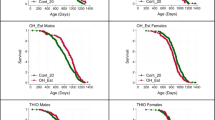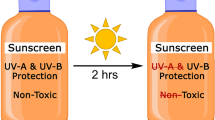Abstract
In search of photoprotective agents, we recently demonstrated a protective effect of 1,25-dihydroxyvitamin D3 [1,25(OH)2D3] against different events mediated by ultraviolet B (UVB) in human keratinocytes. Pharmacological doses of 1,25(OH)2D3 were required to obtain significant UVB protection; however, these doses cannot be used in vivo due to the calcemic properties of 1,25(OH)2D3. Therefore, we evaluated the photoprotective capacities of two low-calcemic 14-epi analogues of 1,25(OH)2D3, 19-nor-14-epi-23-yne-1,25(OH)2D3 (TX 522) and 19-nor-14,20-bisepi-23-yne-1,25(OH)2D3 (TX 527). Using cultured human keratinocytes, we investigated the influence of TX 522 and TX 527 on two hallmark events in UVB-irradiated keratinocytes: the induction of apoptosis and the production of interleukin-6 (IL-6). Treatment of the keratinocytes with TX 522 or TX 527, 24 h before irradiation, resulted in a significant and dose-dependent reduction of both UVB-induced apoptosis and IL-6 production. Both analogues were equally efficient in their anti-UVB effects and at least 100 times more potent than 1,25(OH)2D3. We further demonstrated that metallothionein (MT) mRNA expression was clearly induced by 1,25(OH)2D3 and both analogues. MT acts as a radical scavenger in oxygen-mediated UVB injury and its induction may therefore be relevant for the anti-UVB effects of 1,25(OH)2D3 and both analogues. Taken together, these findings create new perspectives for the use of active vitamin D analogues as photoprotective agents.






Similar content being viewed by others
References
Honigsmann H (2002) Erythema and pigmentation. Photodermatol Photoimmunol Photomed 18:75–81
Garssen J, van Loveren H (2001) Effects of ultraviolet exposure on the immune system. Crit Rev Immunol 21:359–397
Fisher GJ, Wang ZQ, Datta SC, Varani J, Kang S, Voorhees JJ (1997) Pathophysiology of premature skin aging induced by ultraviolet light. N Engl J Med 337:1419–1428
de Gruijl FR (1999) Skin cancer and solar UV radiation. Eur J Cancer 35:2003–2009
De Haes P, Garmyn M, Degreef H, Vantieghem K, Bouillon R, Segaert S (2003) 1,25-Dihydroxyvitamin D3 inhibits ultraviolet B-induced apoptosis, Jun kinase activation and interleukin-6 production in primary human keratinocytes. J Cell Biochem 89:663–673
Bouillon R, Okamura WH, Norman AW (1995) Structure-function relationships in the vitamin D endocrine system. Endocr Rev 16:200–257
Verlinden L, Verstuyf A, Quack M, Van Camp M, Van Etten E, De Clercq P, Vandewalle M, Carlberg C, Bouillon R (2001) Interaction of two novel 14-epivitamin D3 analogs with vitamin D3 receptor-retinoid X receptor heterodimers on vitamin D3 responsive elements. J Bone Miner Res 16:625–638
Segaert S, Garmyn M, Degreef H, Bouillon R (1997) Retinoic acid modulates the anti-proliferative effect of 1,25-dihydroxyvitamin D3 in cultured human epidermal keratinocytes. J Invest Dermatol 109:46–54
Kulms D, Zeise E, Poppelmann B, Schwarz T (2002) DNA damage, death receptor activation and reactive oxygen species contribute to ultraviolet radiation-induced apoptosis in an essential and independent way. Oncogene 21:5844–5851
Urbanski A, Schwarz T, Neuner P, Krutmann J, Kirnbauer R, Köck A, Luger TA (1990) Ultraviolet light induces increased circulating interleukin-6 in humans. J Invest Dermatol 94:808–811
Kirnbauer R, Kock A, Neuner P, Forster E, Krutmann J, Urbanski A, Schauer E, Ansel JC, Schwarz T, Luger TA (1991) Regulation of epidermal cell interleukin-6 production by UV light and corticosteroids. J Invest Dermatol 96:484–489
Nishimura N, Tohyama C, Satoh M, Nishimura H, Reeve VE (1999) Defective immune response and severe skin damage following UVB irradiation in interleukin-6-deficient mice. Immunology 97:77–83
Jee SH, Shen SC, Chiu HC, Tsai WL, Kuo ML (2001) Overexpression of interleukin-6 in human basal cell carcinoma cell lines increases anti-apoptotic activity and tumorigenic potency. Oncogene 20:198–208
Hanada K, Sawamura D, Nakano H, Hashimoto I (1995) Possible role of 1,25-dihydroxyvitamin D3-induced metallothionein in photoprotection against UVB injury in mouse skin and cultured rat keratinocytes. J Dermatol Sci 9:203–208
Lee J-H, Youn JI (1998) The photoprotective effect of 1,25-dihydroxyvitamin D3 on ultraviolet light B-induced damage in keratinocytes and its mechanism of action. J Dermatol Sci 18:11–18
Davis SR, Cousins RJ (2000) Metallothionein expression in animals: a physiological perspective on function. J Nutr 130:1085–1088
Reeve VE, Nishimura N, Bosnic M, Michalska AE, Choo KHA (2000) Lack of metallothionein-I and -II exacerbates the immunosuppressive effect of ultraviolet B radiation and cis-urocanic acid in mice. Immunology 100:399–404
Hanada K, Sawamura D, Tamai K, Baba T, Hashimoto I, Muramatsu T, Miura N, Naganuma A (1998) Novel function of metallothionein in photoprotection: metallothionein-null mouse exhibits reduced tolerance against ultraviolet B injury in the skin. J Invest Dermatol 111:582–585
Budihardjo I, Oliver H, Lutter M, Luo X, Wang X (1999) Biochemical pathways of caspase activation during apoptosis. Annu Rev Cell Dev Biol 15:269–290
Karasawa M, Hosoi J, Hashiba H, Nose K, Tohyama C, Abe E, Suda T, Kuroki T (1987) Regulation of metallothionein gene expression by 1α,25-dihydroxyvitamin D3 in cultured cells and in mice. Proc Natl Acad Sci U S A 84:8810–8813
Verstuyf A, Segaert S, Verlinden L, Bouillon R, Mathieu C (2000) Recent developments in the use of vitamin D analogues. Expert Opin Investig Drugs 9:443–455
van de Kerkhof PC (1998) An update on vitamin D3 analogues in the treatment of psoriasis. Skin Pharmacol Appl Skin Physiol 11:2–10
Maynard DF, Trankle WG, Norman AW, Okamura WH (1994) 14-epi stereoisomers of 25-hydroxy- and 1α,25-dihydroxyvitamin D3: synthesis, isomerization to previtamins, and biological studies. J Med Chem 37:2387–2393
Kulms D, Schwarz T (2002) Mechanisms of UV-induced signal transduction. J Dermatol 29:189–196
Osborne JE, Hutchinson PE (2002) Vitamin D and systemic cancer: is this relevant to malignant melanoma? Br J Dermatol 147:197–213
Manggau M, Kim DS, Ruwisch L, Vogler R, Korting HC, Schäfer-korting M, Kleuser B (2001) 1α,25-Dihydroxyvitamin D3 protects human keratinocytes from apoptosis by the formation of sphingosine-1-phosphate. J Invest Dermatol 117:1241–1249
Benassi L, Ottani D, Fantini F, Marconi A, Chiodino C, Giannetti A, Pincelli C (1997) 1,25-Dihydroxyvitamin D3, transforming growth factor β1, calcium, and ultraviolet B radiation induce apoptosis in cultured human keratinocytes. J Invest Dermatol 109:276–282
Luger TA, Schwarz T, Kalden H, Scholzen T, Schwarz A, Brzoska T (1999) Role of epidermal cell-derived α-melanocyte stimulating hormone in ultraviolet light mediated local immunosuppression. Ann N Y Acad Sci 885:209–216
Komine M, Watabe Y, Shimaoka S, Sato F, Kake K, Nishina H, Ohtsuki M, Nakagawa K, Tamaki K (1999) The action of a novel vitamin D3 analogue, OCT, on immunomodulatory function of keratinocytes and lymphocytes. Arch Dermatol Res 291:500–506
Hanada K, Baba T, Hashimoto I, Fukui R, Watanabe S (1993) Possible role of cutaneous metallothionein in protection against photo-oxidative stress—epidermal localization and scavenging activity for superoxide and hydroxyl radicals. Photodermatol Photoimmunol Photomed 9:209–213
Wenk J, Brenneisen P, Meewes C, Wlaschek M, Peters T, Blaudschun R, Ma W, Kuhr L, Schneider L, Scharffetter-Kochanek K (2001) UV-induced oxidative stress and photoaging. Curr Probl Dermatol 29:83–94
Kawanishi S, Hiraku Y, Oikawa S (2001) Mechanism of guanine-specific DNA damage by oxidative stress and its role in carcinogenesis and aging. Mutat Res 488:65–76
Ichihashi M, Ahmed NU, Budiyanto A, Wu A, Bito T, Ueda M, Osawa T (2000) Preventive effect of antioxidant on ultraviolet-induced skin cancer in mice. J Dermatol Sci 23 [Suppl 1]:S45–50
Afaq F, Mukhtar H (2002) Photochemoprevention by botanical antioxidants. Skin Pharmacol Appl Skin Physiol 15:297–306
Acknowledgements
We wish to thank Petra Windmolders and Suzanne Marcelis for their excellent technical assistance. This work was supported by research grants from the Fund for Scientific Research-Flanders (Belgium) (FWO). P. De Haes is a Research Assistant of the Fund for Scientific Research-Flanders and S. Segaert is a Postdoctoral Fellow of the Fund for Scientific Research-Flanders.
Author information
Authors and Affiliations
Corresponding author
Rights and permissions
About this article
Cite this article
De Haes, P., Garmyn, M., Verstuyf, A. et al. Two 14-epi analogues of 1,25-dihydroxyvitamin D3 protect human keratinocytes against the effects of UVB. Arch Dermatol Res 295, 527–534 (2004). https://doi.org/10.1007/s00403-004-0451-x
Received:
Accepted:
Published:
Issue Date:
DOI: https://doi.org/10.1007/s00403-004-0451-x




